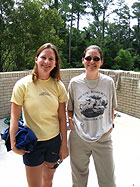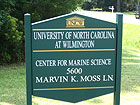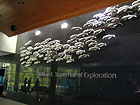

 | |||||||||||||
|
|
Journals 2006/2007Anna Hilton
August 6, 2006 My last field research trip for the Tidal Creeks Monitoring and Assessment Project was in Wilmington, North Carolina. Wilmington is located between Cape Fear River and the Atlantic Intracoastal Waterway. Our research trip will last for four sampling days and four homesick nights in the Ameri-Stay Inn. Our team will monitor three orders on Hewletts Creek and three orders on Whiskey Creek. Hewletts Creek is the largest of six suburban creeks in the same area in Wilmington on the Intracoastal Waterway including Futch, Pages, Howe, Bradley, Hewletts, and Whiskey creeks. The creeks are bordered by a mixture of upscale homes, forest, marsh, and docks. I expected to see clean creeks with many small fish and crabs. I googled Hewletts Creek online and was surprised that the creek was in the news in February 2006. The online article reported three million gallons of sewage spilled into Hewletts Creek after a break in a connection on a sewer main near a pump station. It killed fish and crabs, soiled waterfowl and sparked a swimming advisory in the creek. The pipe is part of a sewer system that had malfunctioned in two previous spills. Needless to say the residents in the nearby neighborhood were exasperated and met for a public forum at Wilmington City Hall. Search Hewletts Creek on Starnewsonline.com (http://starnewsonline.com/apps/pbcs.dll/search) for reports about the sewage spills. I learned from reading the articles that a sewage leak is not a quick, inexpensive, or easy fix. I was reminded of Guys remarks about policies involving development near the coastal environment, "Policy making is reactive not proactive." That means that people usually try to fix pollution that becomes a problem instead of preventing the problems by planning development carefully. Unfortunately repair of faulty sewage systems involve more reactive decision making than proactive planning!
We took the full research crew to Wilmington which included several of the Hollings Marine Laboratory partners including the SCDNR (South Carolina Department of Natural Resources) crew I had worked with at Village Creek in Frogmore. Guy DiDonato, (PI) Principal Investigator for the Tidal Creeks Monitoring and Assessment; Cynthia Cooksey with the National Oceanic and Atmospheric Administration (NOAA); Lisa Hayes, a research assistant for the National Oceanic and Atmospheric Administration (NOAA); Angela Salisbury with the Department of Natural Resources (DNR); and Patrick Biondo, a natural resource technician who also works for DNR. The graduate students included Travis Washburn, Mark Tibbett, Sara Jones, and Kolo Rathburn. I was very excited that Denise Sanger, a (PI) Principal Investigator of the project, would be joining us in Wilmington for the creek sampling. I knew that Fred Holland, the director of Hollings Marine Laboratory, had traveled with the other researchers to Sapelo Island in Georgia and had suffered a bunk house at night so that he could participate in the field research. (He is reported to be king of the pluff mud walkers. What is his secret?) Many of the graduate students claimed that the actual field work was a favorite part of their job description and I agreed that although challenging, sampling the creeks was a whole lot of fun! I have discovered that the teachers and scientists I have met during the ARMADA Project research experience have been the most enthusiastic and dedicated people I have ever met! Is it because they are so involved in the important conservation research they are doing?
We drove into Wilmington and headed straight to the Center of Marine Science at the University of North Carolina at Wilmington (http://www.uncw.edu/cmsr). Sara had attended classes at the Center of Marine Science and told us to get ready to be impressed. Everybody was! The Center of Marine Science is a cutting edge laboratory and university. Heather Wells, a research biologist, was Guy's contact for the Center of Marine Science. Heather met us at the gate after a call from Guy as we approached Wilmington. Heather was upbeat and took us for a quick tour to show Guy the accommodations available to us at the marine science center.
|
||||||||||||


